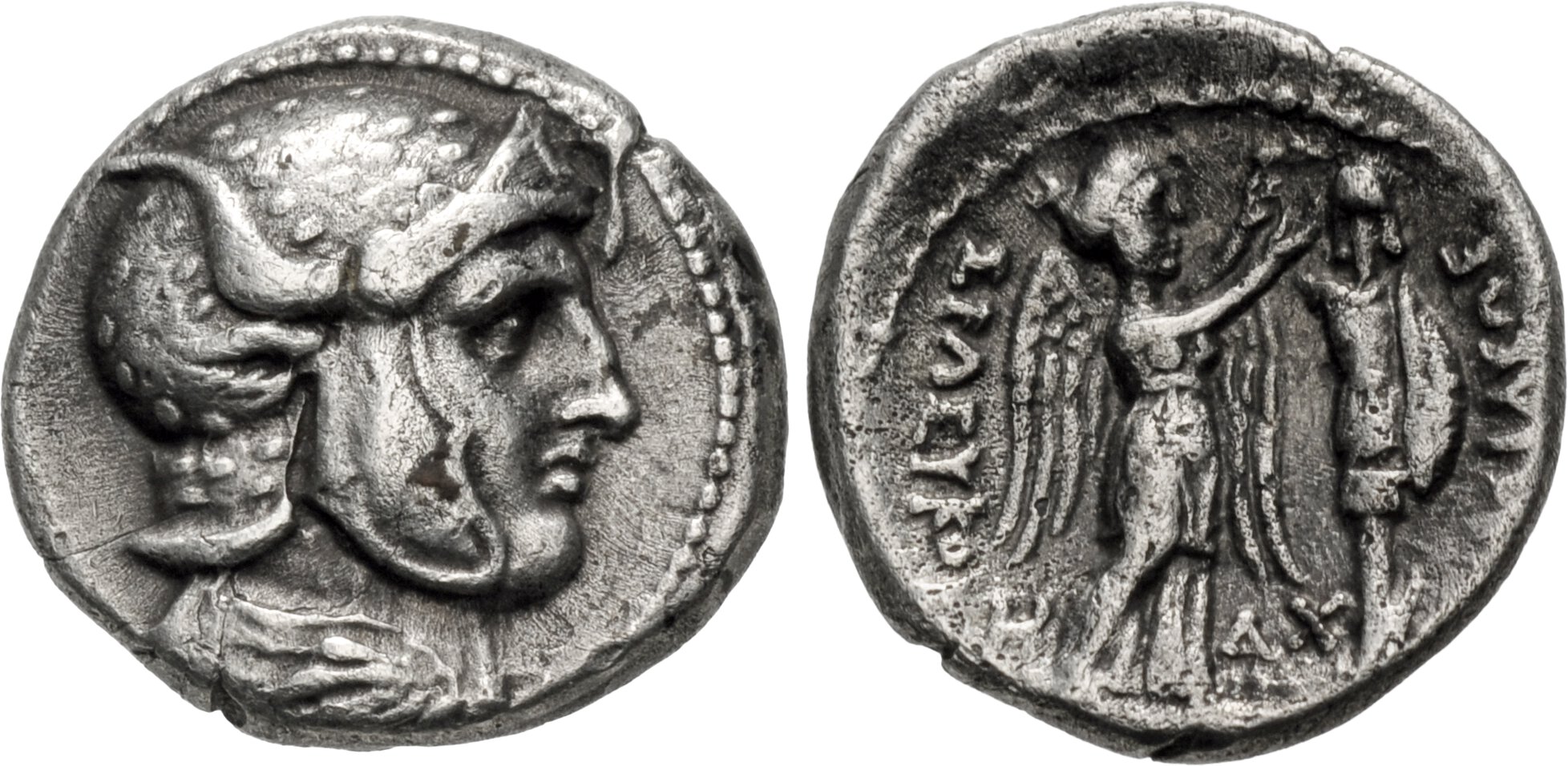Susa (Seleucus I), silver, hemidrachms (helmeted head/Nike and trophy) (301-295 BCE)
From SILVER
(Redirected from S 404 - Susa (Seleucus I), silver, hemidrachms (301-295 BCE))
301 BCE - 295 BCE Silver 588 kg
Description
| ObverseInscription or printing placed on the obverse.: | Head of Seleucus I Nikator right, wearing a helmet covered by a panther skin, with ears and horns of a bull, a panther skin around the neck. Border of dots. |
| ReverseInscription or printing placed on the reverse.: | BAΣΙΛΕΩΣ ΣΕΛΕΥΚΟΥ (Greek).Nike right crowning a trophee. Between them, a monogram, AX or ΔI. In the field, H or a monogram. Border of dots. |
Mint and issuing power
| MintIdentifies the place of manufacture or issue of a numismatic object.: | Susa | Ancient regionAncient region.: | Mesopotamia | Modern countryModern country: Iran | AuthorityIdentifies the issuing power. The authority can be "pretended" when the name or the portrait of X is on the coin but he/she was not the issuing power. It can also be "uncertain" when there is no mention of X on the coin but he/she was the issuing power according to the historical sources: | Seleucid Dynasty (312-63 BC), Seleucus I Nicator (satrap in 321-305 BC and Seleucid king in 305-281 BC) |
Chronology
| FromIdentifies the initial date in a range assigned in a numismatic context. | 301 BCE | toIdentifies the final date in a range assigned in a numismatic context.. | 295 BCE | PeriodTime period of the numismatic object.: Hellenistic 323-30 BC |
Physical description
| MetalThe physical material (usually metal) from which an object is made.: | Silver |
Median weightMedian of the weights of numismatic objects (in grams). in grams | 1.90 | DenominationTerm indicating the value of a numismatic object. Examples: tetradrachm, chalkous, denarius.: | hemidrachm |
StandardStandard.: | Attic |
Image

S404 Susa Seleucus I hemidrachms trophy.jpg [1]
References
| Die study referencePublication of the study: | Marest-Caffey 20161Marest-Caffey 2016, p. 45, n° 254-264 (Group 3) | ||
| Coin series referenceReference to coin series study: | ESM2ESM, n° 419. SC I, n° 175, HGC 93HGC 9, n° 49 | ||
| Coin series web referenceCoin series web references: | |||
Obverse dies distribution
Reverse dies distribution
no distribution is available
Quantification
| Number of obversesNumber of obverse dies. ᵖ (o) | 7 | Number of singletons (o1)The number of singleton coins. ᵖ | 4 |
| Number of reverse diesNumber of reverse dies. (r) | 8 | Number of coinsNumber of coins. (n) | 11 |
| Coins per obverse dieNumber of coins per obverse die. (n/o) | 1.57 | Coins per reverse dieNumber of coins per reverse die. (n/r) | 1.38 |
| Reverse per obverse ratioRatio of obverse dies divided by reverse dies. (r/o) | 1.14 | Percentage of singletons (o1)number of coins (n) divided by the number of singletons (o1) ᵖ | 57.14 % |
| Original number of dies (O) (Carter 1983 formula)The estimation of the number of coins according to Carter 1983 ᵖ | 15.48 | Coins struck if 20,000 as average productivity per dieCoins made if the average productivity for obverses (according to Carter) is 20,000. ᵖ | 309,600 |
| Original number of dies (O) (Esty 2011 formula)The estimation of the number of coins according to the singleton formula in Esty 2011 ᵖ (O) | 19.25 | Survival rate if 20,000 as average productivity per dieSurvival rate if average productivity is 20,000. ᵖ | 0.00004 |
| Coverage (o = % of O) (Esty 1984 formula)Esty 1984 - coverage (% of O) ᵖ (o = % of O) | 63.64% | Die productivity if survival rate 1/2,000Average productivity if survival rate is 1/2,000. ᵖ | 1,421.19 |
| Weight of silver (in kg) if 20,000 coins per die (O = Carter formula)Carter 1983 * Median weight * 20000 (*10 if gold or electrum) ᵖ | 588 kg <br /> 588 kg | Die productivity if survival rate 1/5,000Average productivity if survival rate is 1/5,000. ᵖ | 3,552.97 |
Remarks
Most likely one single workstation
References
- ^ Marest-Caffey, Laure (2016), "Seleukos I's Victory Coinage of Susa Revisited: A Die Study and Commentary", American Journal of Numismatic, 28, p. 1-64.
- ^ Newell, Edawrd T. (1938), The coinage of the eastern Seleucid mints, from Seleucus I to Antiochus III, Numismatic Studies 1, New York, 307 p., LVI pl.
- ^ Hoover, Oliver D. (2009), Handbook of ancient Syrian coins : royal and civic issues, fourth to first centuries BC, The Handbook of Greek Coinage 9, Lancaster, lxix, 332 p.